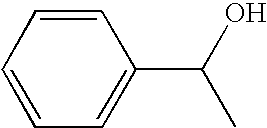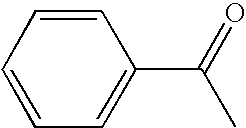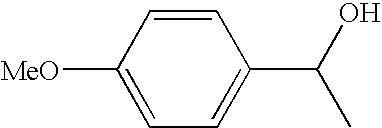Processes for producing oxide with higher oxidation than alcohol
a technology of oxidation and alcohol, which is applied in the direction of oxidation preparation of carbonyl compounds, electrolytic organic production, carboxylic compound preparation, etc., can solve the problems of large amount of supporting electrolyte, difficult to bring about oxidation reaction, and inability to give fully satisfactory yields of contemplated products, etc., to achieve high yield, high efficiency, and high oxidizing degree
- Summary
- Abstract
- Description
- Claims
- Application Information
AI Technical Summary
Benefits of technology
Problems solved by technology
Method used
Image
Examples
reference example 1
[0048]Dissolved in 2 ml of methylene chloride were 100 mg (0.64 mmol) of 1-(p-chlorophenyl)ethyl alcohol and 1.9 mg (0.0064 mmol) of 4-benzoyloxy-2,6-tetramethylpiperidine-N-oxyl compound. To the solution was added dropwise 5 ml of an aqueous solution of 3.52 mmol (as the quantity of active chlorine) of sodium hypochlorite at a temperature of 1 to 2° C. After addition, the reaction mixture was separated and the methylene chloride layer was concentrated Purification was conducted by column chromatography, whereby 2 mg (2% yield) of 1-(p-chlorophenyl)ethyl-1-one was given and 95% of 1-(p-chlorophenyl)ethyl alcohol serving as the raw material was recovered.
example 1
[0049]Uniformly dissolved in 2 ml of acetone were 157 mg (1.0 mmol) of 1-(p-chlorophenyl)ethyl alcohol and 3.0 mg (0.01 mmol) of 4-benzoyloxy-2,6-tetramethylpiperidine-N-oxyl compound. To the solution was added 1 g of silica gel (product of Merck, grade 9385) and the mixture was vigorously stirred for 5 minutes. Then the acetone was distilled off under reduced pressure. The obtained silica gel was placed into an eggplant type flask, which was immersed in an ice bath and was cooled to 1 to 2° C. A solution of sodium hypochlorite (5 ml of aqueous solution containing 1.1 mmols of active oxygen) which was cooled was added gradually dropwise thereto. After completion of addition, the reaction mixture was stirred at the same temperature for 30 minutes. After completion of agitation, the reaction mixture was filtered, and the silica gel remaining on the filter paper was washed with 5 ml of acetone, whereby the desired product and catalyst were recovered. Acetone was removed by concentratio...
example 2
[0052]A reaction was carried out in the same manner as in Example 1 except that the amount of hypochlorous acid was changed as follows:
[0053]
Amount of hypochlorous acid(mole equivalent)Yield (%)1.5953.5945.592
[0054]1H-NMR data of obtained product were identical with those of obtained product in Example 1.
PUM
 Login to View More
Login to View More Abstract
Description
Claims
Application Information
 Login to View More
Login to View More - R&D
- Intellectual Property
- Life Sciences
- Materials
- Tech Scout
- Unparalleled Data Quality
- Higher Quality Content
- 60% Fewer Hallucinations
Browse by: Latest US Patents, China's latest patents, Technical Efficacy Thesaurus, Application Domain, Technology Topic, Popular Technical Reports.
© 2025 PatSnap. All rights reserved.Legal|Privacy policy|Modern Slavery Act Transparency Statement|Sitemap|About US| Contact US: help@patsnap.com



